-
Happy Birthday ICMag! Been 20 years since Gypsy Nirvana created the forum! We are celebrating with a 4/20 Giveaway and by launching a new Patreon tier called "420club". You can read more here.
-
Important notice: ICMag's T.O.U. has been updated. Please review it here. For your convenience, it is also available in the main forum menu, under 'Quick Links"!
You are using an out of date browser. It may not display this or other websites correctly.
You should upgrade or use an alternative browser.
You should upgrade or use an alternative browser.
Aphotic's No Till- Indoor- Raised Bed- Experience & Pseudo Knowledge Emporium
- Thread starter Aphotic
- Start date
less plants more co2 cause it doesnt be used by plants...it have to be the way that the soil produces co2 too...especialy when its 110%alive....
are you able to exclude other sources of the co2 to youre room..`?
how much did you pay for the co2 meter...?
The c02 meter was around $300, my ambient levels are 400 or so, I first noticed the high readings a couple of weeks ago, and I thought it must be from me standing next to the meter, but I hadn't been in the room very long. But then I kept noticing the high levels as soon as I opened the door, this is at lights out when the ventilation is off. Or inbetwwen air cycles, I exchange my air once every 30min, I decided to wait that long by watching how low the co2 would get, and this saves me power in the summer months. This is been when no people or animals are any where near the intake source.
You are exactly right the microbes are giving off co2 during respiration. I think it was Lapides who was bragging that his living soil keeps his room at a constant 1000ppm without any artificial co2 source. I also run my veg room with no air exchange.So, I have a C02 meter in my flower room, but I'm not running C02. I switched to no till last cycle, and while my room was full of plants, I averaged around 400ppm. Now that the crops been cut, I'm maintaining 700-800ppm?
I have a small amount of plants still in the room that I use as amendments for my soil, so I keep the lights on, and everything running in between cycles. I exchange my air in the room on a timer, as my air conditioner takes care of the temps. Anyways, in between air exchanges, the c02 levels maintain between 700-800ppm. The air drawn in from outside is around 400. My soil is very alive, with lots of mulch. My best guess is that my soil is generating c02.
Anyone else encountering this?
wasgedn
Active member
wow...this is a great news...see organic growing...hehe...his living soil keeps his room at a constant 1000ppm without any artificial co2 source.
so cool....no artificial co2 source is needed on living soil
Last edited:
You are exactly right the microbes are giving off co2 during respiration. I think it was Lapides who was bragging that his living soil keeps his room at a constant 1000ppm without any artificial co2 source. I also run my veg room with no air exchange.
Next cycle I'll try running the exchange further apart and seeing how low, or high the figures get, it would be great if I could maintain even 600ppm with a room full of plants. I've read of interesting ways of drawing higher c02 levels into your rooms. One grower I read a post by draws his air from the room containing his hot water heater and furnace, both being gas, were generating decent levels of co2. Or drawing air from your bedroom, if your lights in your rooms are on while you're sleeping raises things above background levels.
I purchased the meter because I planned on experimenting with alternative co2 sources, I just haven't got around to it. The biggest thing I wanted to take advantage of is brewing beer, new Belgium brewing company actually pipes their co2 from their brewing process next door, to a lab experimenting with bio fuel sources, and the co2 feeds algae crops.
It's been a hectic and trying week here on the farm. We sold half of our herd of goats today, and it was difficult to see them go, but 14 goats were just too taxing on the land without having it split up into pastures yet. We've been struggling to keep our outdoor gardens watered, now that we have three times as much planted this year, than we had last year. I'll have to snap some pictures and post them tomorrow, our main garden turned out really well this year. When we first moved here the soil in the main garden was just sand and clay, that dried and cracked like a dried out lake bed in the sun.
We've been working nonstop for a few months now without a break, and the stress is taking its toll on our moral. As if that weren't hard enough to cope with, we had several deaths on the farm this week, and after an investigation it looks like it was murder! Yet just as those lives were extinguished, elswhere new life was born, and yesterday there were even a couple of adoptions. Such is life on a farm.
First lets cover the murders! A couple of days ago I had been working all day out in the sun, by the time I was done it was getting dark, I was exhausted, but there were a few things I still needed to take care of in the grow room. Ive been battling a fungus gnat infestation from hell, I needed to apply another round of DTI, change out the fly cards, and vacuum up the flower room floor. After that I wanted to check the progress of things in the cloner, the sad looking clones on the first page of this journal had finally sprouted some roots, and I wanted to see how close they were to being ready. I unplugged the water pump, lifted the lid, there were lots of nice, white, healthy roots. I was pretty excited, I had had my doubts that many would make it. I shut the lid, closed the door, and I was off to bed. I woke up the next day and had to go get some stuff from town, which took most of the day. When I came back that evening, I went to check on the rooms, and make sure everyone was happy, but every one wasn't happy, in fact many were dead...
To my dismay, after a short investigation, I found, that I had failed to plug the water pump back in, I murdered them all. Every time I close my eyes, I can see their little desiccated roots and their once tender leaves, shriveled, and twisted, with their stalks slumped over, forever gazing down, at all the life giving moisture, just out of their reach.
In a daze, I turned my back to their lifleless husks, and opened the door to my mom room. As I struggled to focus through the tears, a glimmer of green caught my eye. New life had broken free from the darkness, and was reaching toward the light. Five new seedlings had been born.
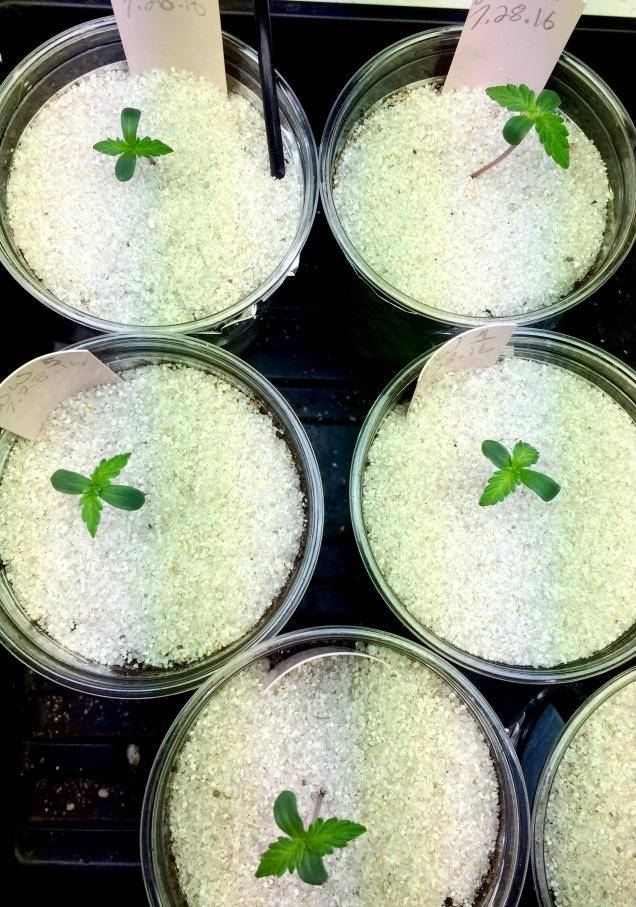
To be continued.....
It's 6:23am and I need some sleep
We've been working nonstop for a few months now without a break, and the stress is taking its toll on our moral. As if that weren't hard enough to cope with, we had several deaths on the farm this week, and after an investigation it looks like it was murder! Yet just as those lives were extinguished, elswhere new life was born, and yesterday there were even a couple of adoptions. Such is life on a farm.
First lets cover the murders! A couple of days ago I had been working all day out in the sun, by the time I was done it was getting dark, I was exhausted, but there were a few things I still needed to take care of in the grow room. Ive been battling a fungus gnat infestation from hell, I needed to apply another round of DTI, change out the fly cards, and vacuum up the flower room floor. After that I wanted to check the progress of things in the cloner, the sad looking clones on the first page of this journal had finally sprouted some roots, and I wanted to see how close they were to being ready. I unplugged the water pump, lifted the lid, there were lots of nice, white, healthy roots. I was pretty excited, I had had my doubts that many would make it. I shut the lid, closed the door, and I was off to bed. I woke up the next day and had to go get some stuff from town, which took most of the day. When I came back that evening, I went to check on the rooms, and make sure everyone was happy, but every one wasn't happy, in fact many were dead...
To my dismay, after a short investigation, I found, that I had failed to plug the water pump back in, I murdered them all. Every time I close my eyes, I can see their little desiccated roots and their once tender leaves, shriveled, and twisted, with their stalks slumped over, forever gazing down, at all the life giving moisture, just out of their reach.
In a daze, I turned my back to their lifleless husks, and opened the door to my mom room. As I struggled to focus through the tears, a glimmer of green caught my eye. New life had broken free from the darkness, and was reaching toward the light. Five new seedlings had been born.
To be continued.....
It's 6:23am and I need some sleep
Pt.II
I'll have to look back at my notes, but I believe it took 7 days for the White Widow seeds to sprout. I was beginning to worry, as the first Afghan seedling broke through the surface 2 days after being planted, and the rest followed in the subsequent three days. The first White Widow seedling broke free of the soil early in the morning, and by the time I checked on them that night, all the rest had sprouted, weird. The pic from my previous post was taken the day they sprouted, this new pic was taken today, right when the lights came on.
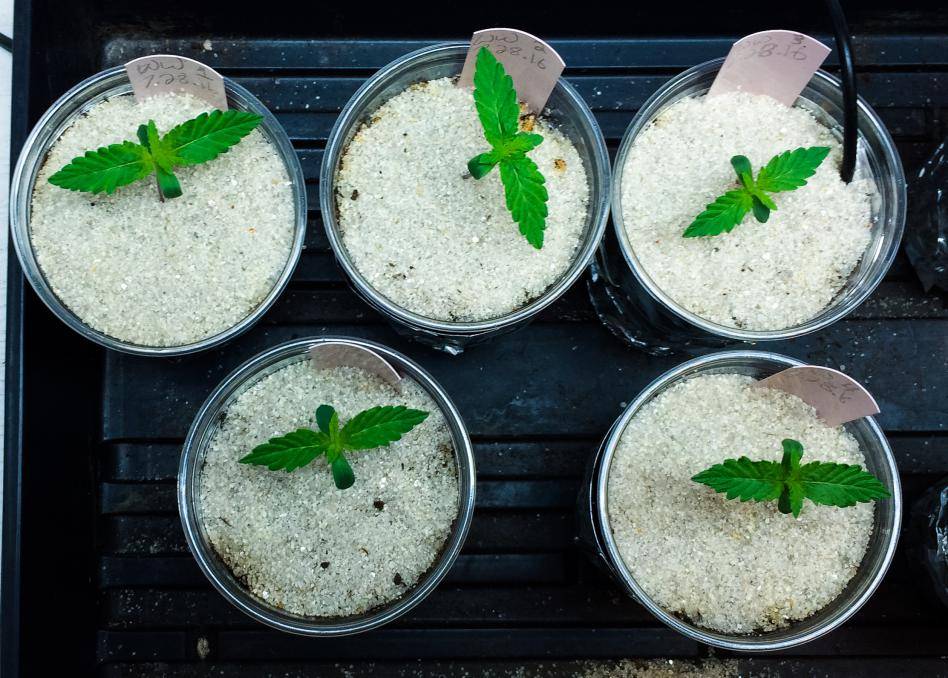
Here's a pic of the young Afghan Kush seedlings, I spent part of yesterday trying to mix a new batch of soil for them, unfortunately the fungus gnats found their way into my bin of screened compost, somehow they got past the lid, there were about 20 or so dead adults stuck to the underside of the lid, and the compost was full of larvae. So I had to stop adding ingredients, and bake my compost. I held the compost at around 140f for about 20min, I took it out of the oven, inspected it, lots of cooked larvae, so I dumped it into my mixing bin, and let it cool over night. I have them placed in the order the sprouted, starting from the upper left hand corner and moving right. The second and third seedlings, first set of true leaves were both very round at the tips, every other seedlings first true leaves were pointed at the tips. I'll keep track of two and three, and see if there are any other differences as they mature.
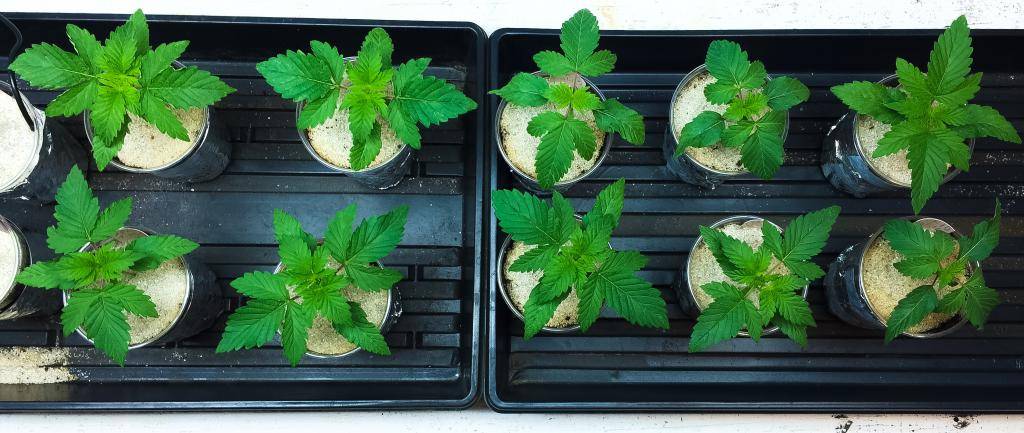
The only cups I had on hand were pretty small, I normally use a bigger clear cup, and slide it into a colored one, so I can check out the root progress. Since these cups are so much smaller I'll have to transplant sooner than I'd like, but the root systems have wrapped around the edges of the cup, in search of more soil. I might transplant them tonight, we'll see how it goes.
The cover crop in the flower room beds is filling in nicely, despite the horrid fungus gnat infestation, I'll be ordering nematodes tonight, I'm hoping that the nematodes, combined with the DTI, and predator mites will do the trick.
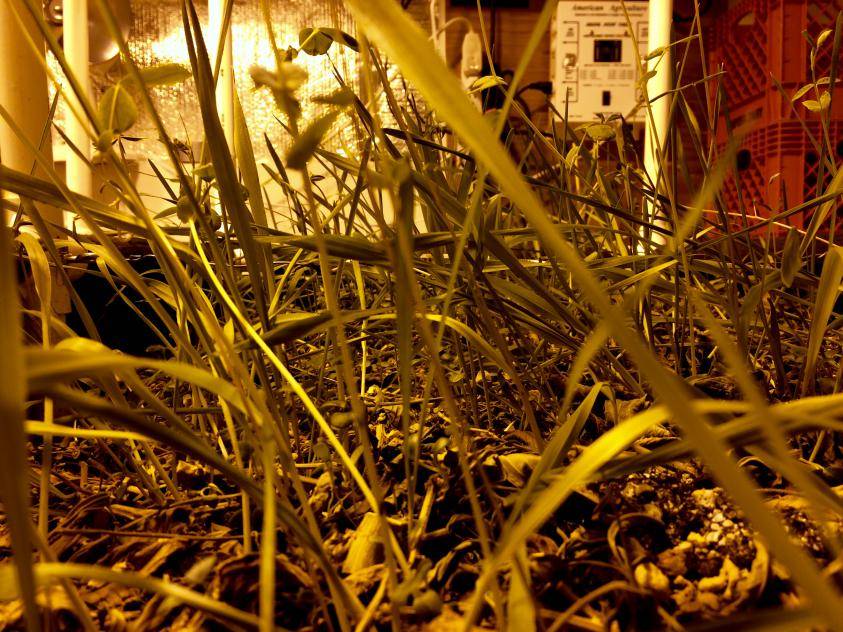
Here's a pic of my comfrey plant taken 9 days ago, followed by one taken today. When cut the Borage takes forever to recover and put out new growth, the comfrey however comes back even stronger after cutting, again and again. So I've come to the conclusion, that if you'd like to grow one indoors, to top dress your pots with, comfrey is the way to go.
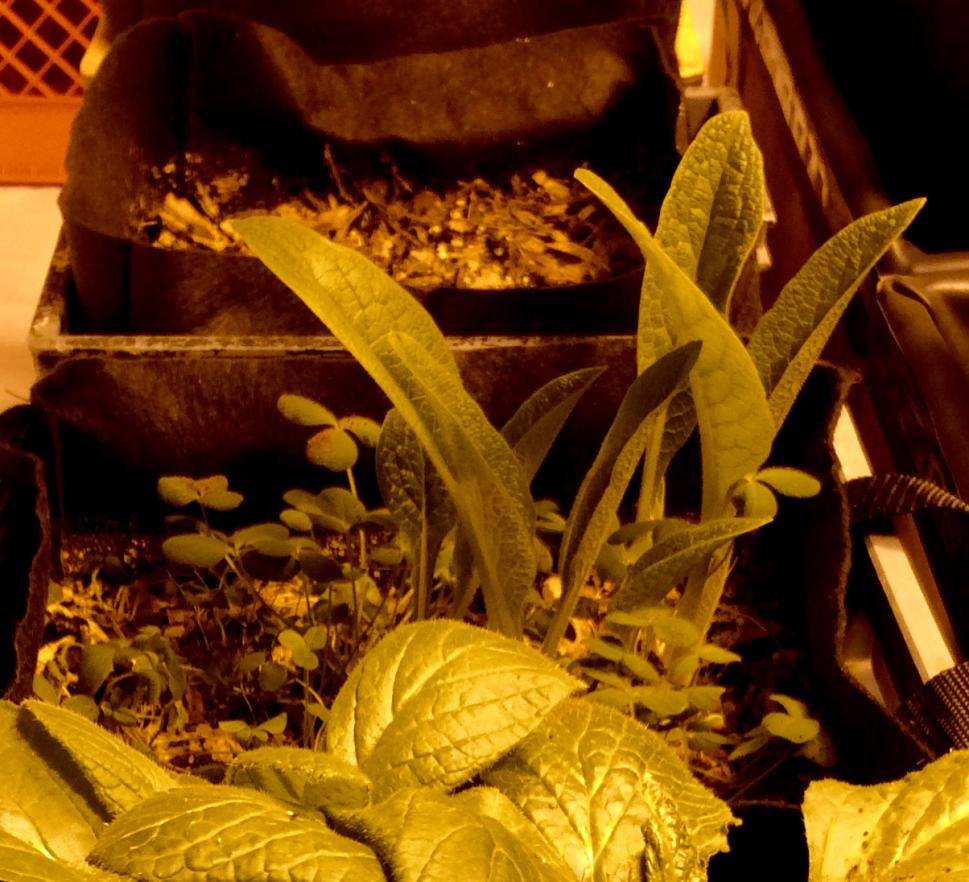
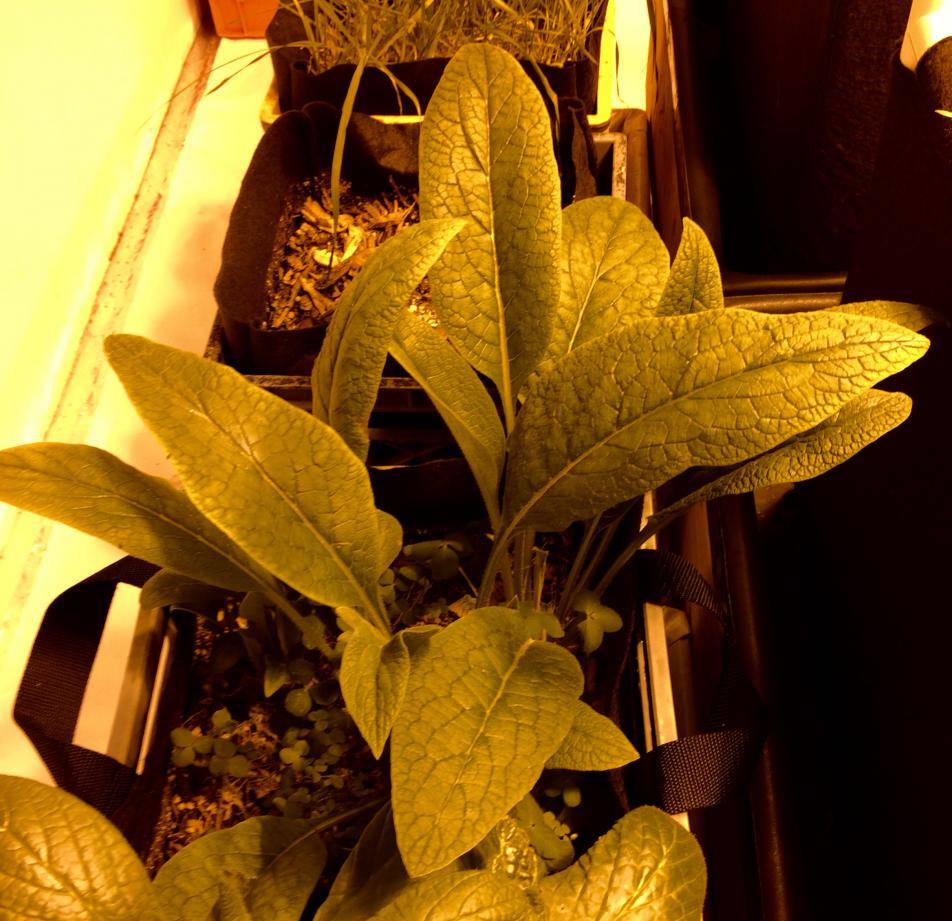
The comfrey in the pictures above was grown from a root cutting from a plant in one of my gardens outside, as time goes on, it's root system will get larger and larger, and growth will increase dramatically.
I'll have to look back at my notes, but I believe it took 7 days for the White Widow seeds to sprout. I was beginning to worry, as the first Afghan seedling broke through the surface 2 days after being planted, and the rest followed in the subsequent three days. The first White Widow seedling broke free of the soil early in the morning, and by the time I checked on them that night, all the rest had sprouted, weird. The pic from my previous post was taken the day they sprouted, this new pic was taken today, right when the lights came on.
Here's a pic of the young Afghan Kush seedlings, I spent part of yesterday trying to mix a new batch of soil for them, unfortunately the fungus gnats found their way into my bin of screened compost, somehow they got past the lid, there were about 20 or so dead adults stuck to the underside of the lid, and the compost was full of larvae. So I had to stop adding ingredients, and bake my compost. I held the compost at around 140f for about 20min, I took it out of the oven, inspected it, lots of cooked larvae, so I dumped it into my mixing bin, and let it cool over night. I have them placed in the order the sprouted, starting from the upper left hand corner and moving right. The second and third seedlings, first set of true leaves were both very round at the tips, every other seedlings first true leaves were pointed at the tips. I'll keep track of two and three, and see if there are any other differences as they mature.
The only cups I had on hand were pretty small, I normally use a bigger clear cup, and slide it into a colored one, so I can check out the root progress. Since these cups are so much smaller I'll have to transplant sooner than I'd like, but the root systems have wrapped around the edges of the cup, in search of more soil. I might transplant them tonight, we'll see how it goes.
The cover crop in the flower room beds is filling in nicely, despite the horrid fungus gnat infestation, I'll be ordering nematodes tonight, I'm hoping that the nematodes, combined with the DTI, and predator mites will do the trick.
Here's a pic of my comfrey plant taken 9 days ago, followed by one taken today. When cut the Borage takes forever to recover and put out new growth, the comfrey however comes back even stronger after cutting, again and again. So I've come to the conclusion, that if you'd like to grow one indoors, to top dress your pots with, comfrey is the way to go.
The comfrey in the pictures above was grown from a root cutting from a plant in one of my gardens outside, as time goes on, it's root system will get larger and larger, and growth will increase dramatically.
Pt.III
"I think we're going to need a bigger boat!"
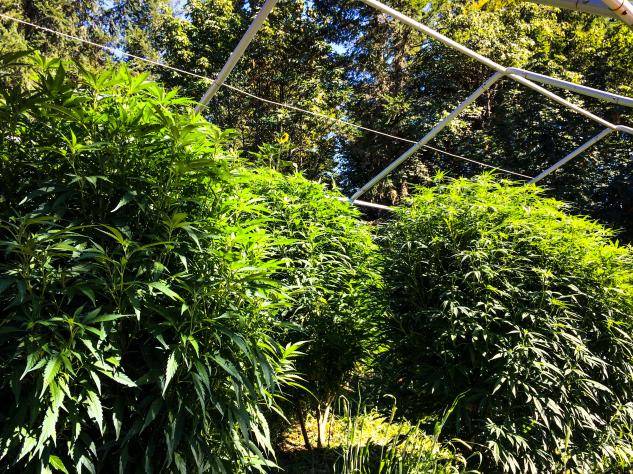
The plants above, have grown higher than the walls of their (carport frame, soon to be greenhouse), the walls are 8' tall, and the peak is around 14'.
The Square Garden
As I've mentioned earlier, we've had a difficult time just keeping up with watering this year, let alone weeding, pruning, etc. It was difficult to get good pics, as there's not really a good place to stand and capture it all in one pic. It's like a jungle in there.
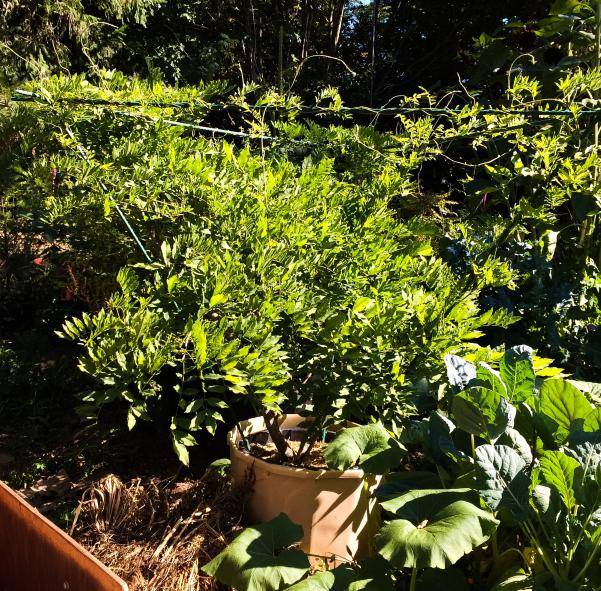
It's hard to tell, but those sunflowers are over 10' tall and the beds are all hügelkultur beds, it's so dry here in the summer it helps with water retention, we wanted to experiment with this style to see if we wanted to apply it to a few hillsides around the farm. Hügelkultur creates fungi dominated soil, so not really ideal for herbaceous plants, but perfect for trees and woody shrubs.
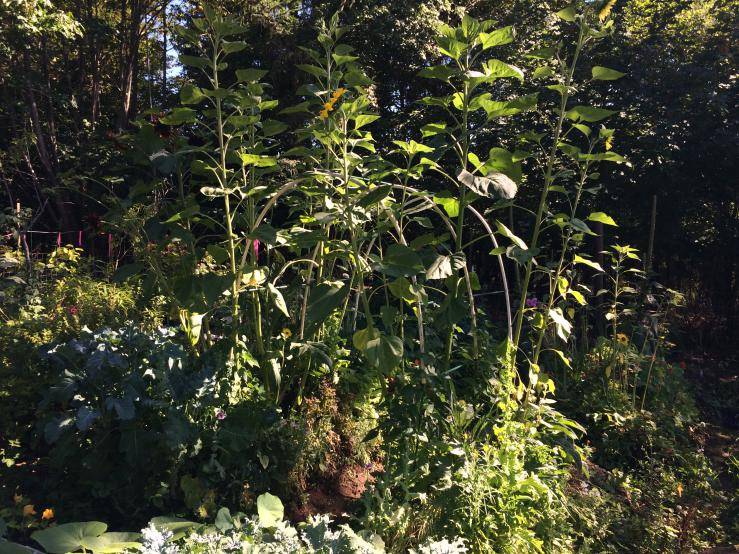
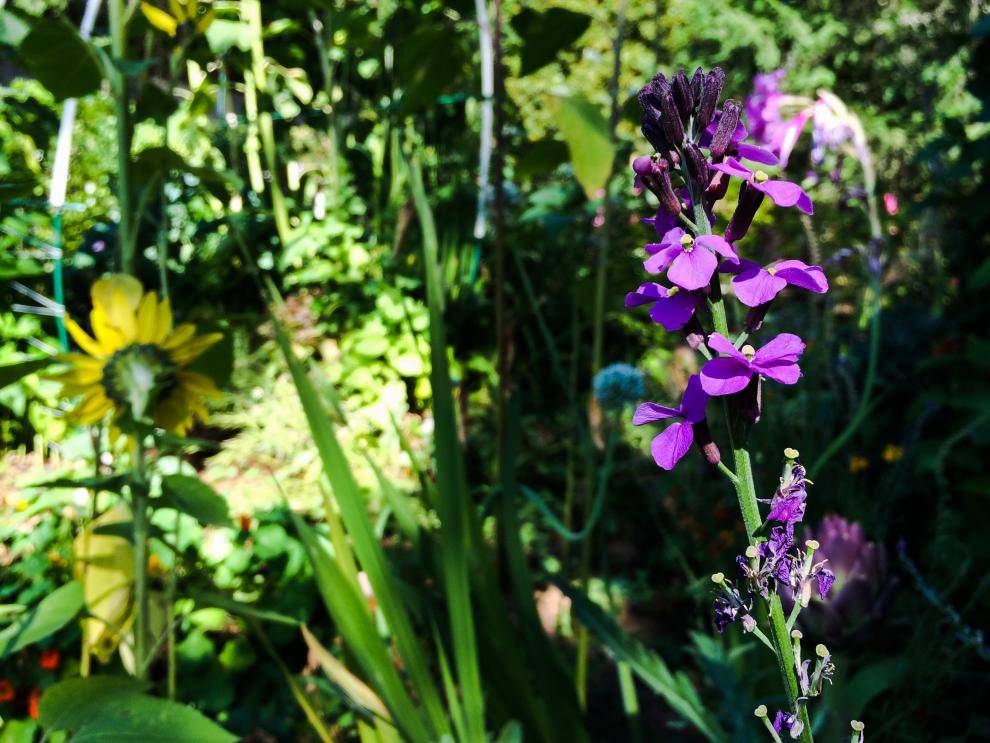
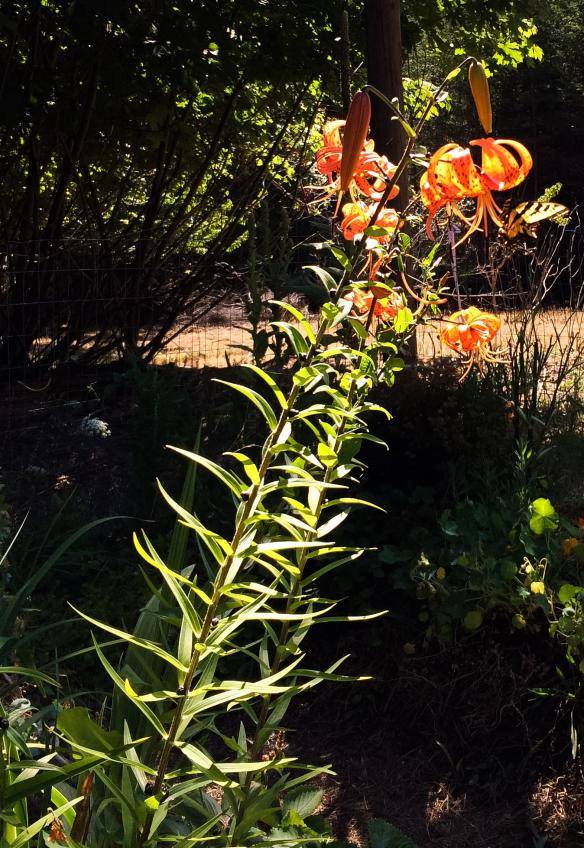
"I think we're going to need a bigger boat!"
The plants above, have grown higher than the walls of their (carport frame, soon to be greenhouse), the walls are 8' tall, and the peak is around 14'.
The Square Garden
As I've mentioned earlier, we've had a difficult time just keeping up with watering this year, let alone weeding, pruning, etc. It was difficult to get good pics, as there's not really a good place to stand and capture it all in one pic. It's like a jungle in there.
It's hard to tell, but those sunflowers are over 10' tall and the beds are all hügelkultur beds, it's so dry here in the summer it helps with water retention, we wanted to experiment with this style to see if we wanted to apply it to a few hillsides around the farm. Hügelkultur creates fungi dominated soil, so not really ideal for herbaceous plants, but perfect for trees and woody shrubs.
Pt.III.5
The Square Garden Continued
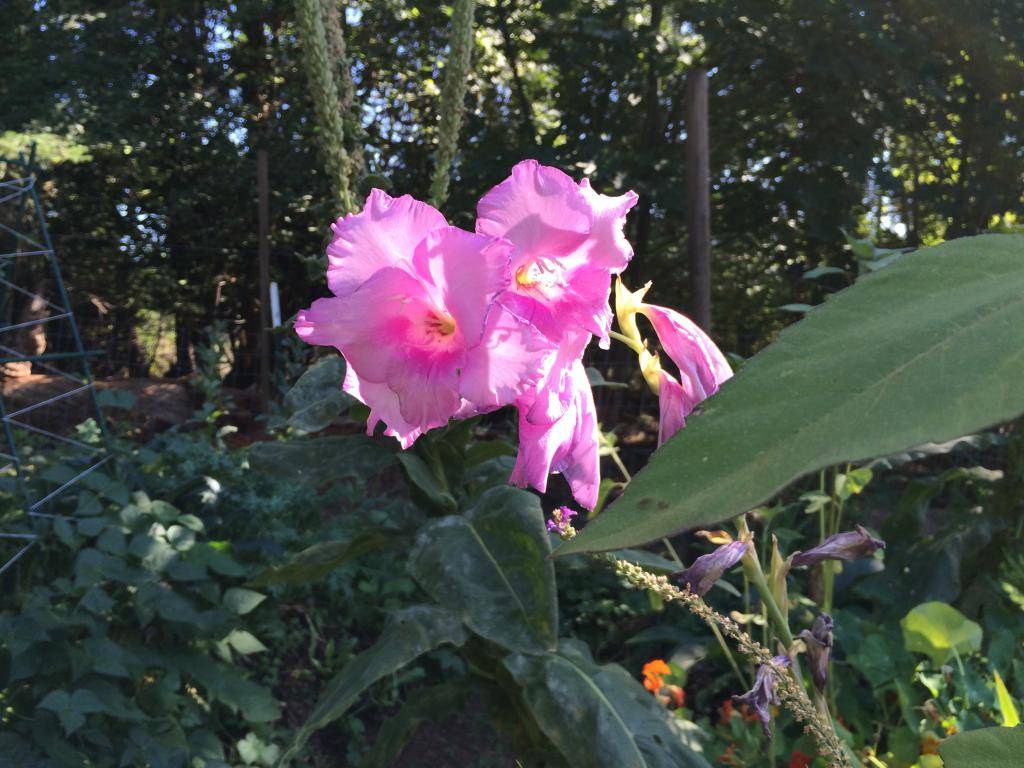
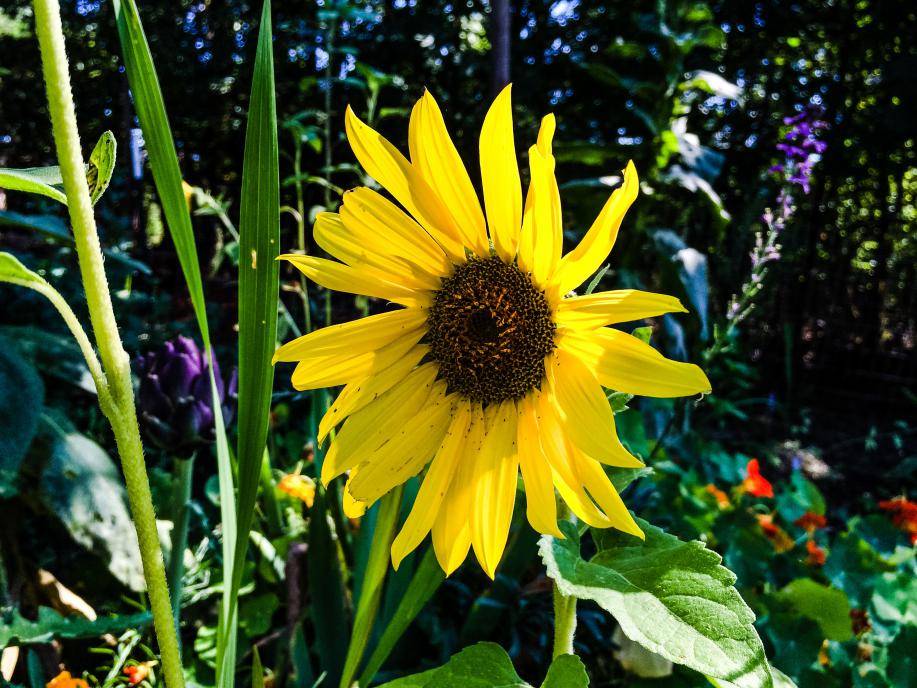
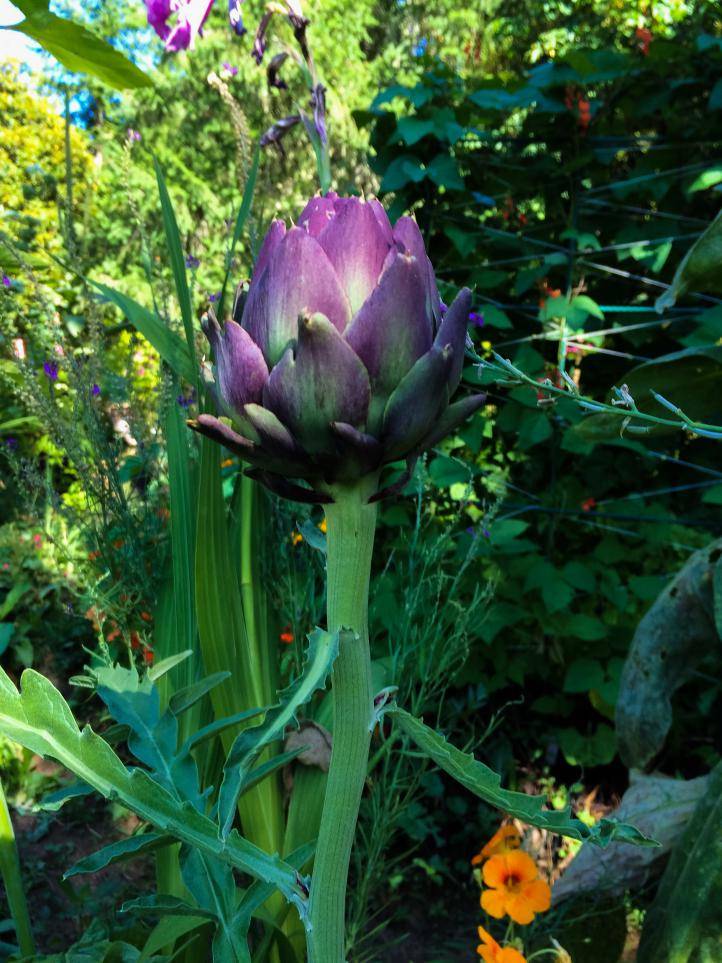
The House Greenhouse
The first greenhouse we built, it's attached to the side of the house, and helps heat the house in the winter.
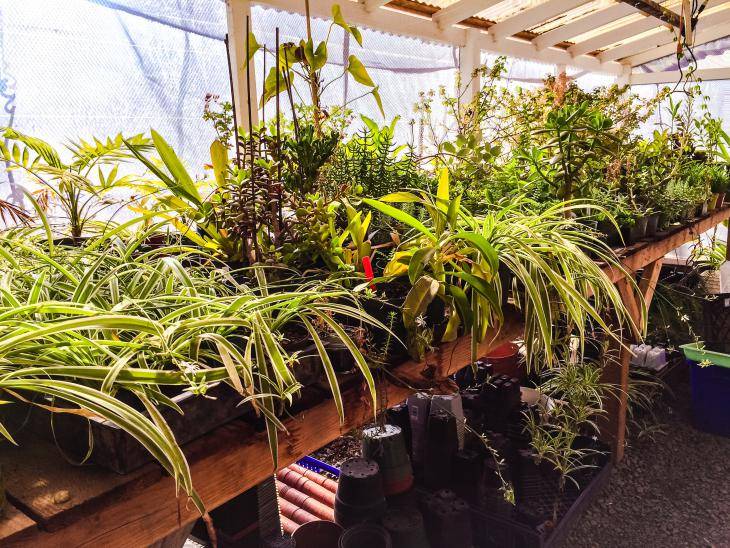
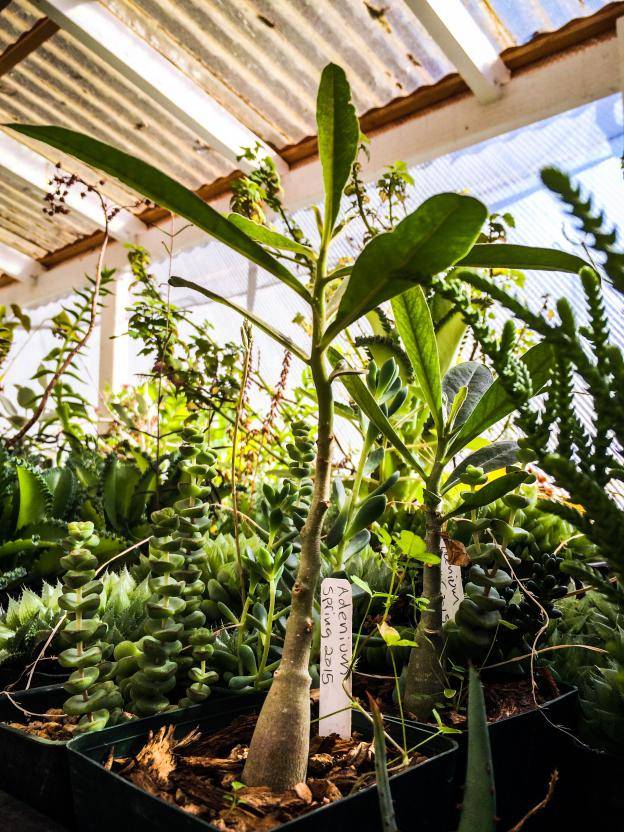
The last picture is an Adenium, in habitat it grows into a large tree, with breathtaking flowers, and seeds similar to a milk pod.
The Square Garden Continued
The House Greenhouse
The first greenhouse we built, it's attached to the side of the house, and helps heat the house in the winter.
The last picture is an Adenium, in habitat it grows into a large tree, with breathtaking flowers, and seeds similar to a milk pod.
Pt.IIII
The Final Chapter...
The Adoption
After losing all of those cuttings, and everything else that went down this week, I was really bummed. So I decided to take a trip down to the dispensary. Like all businesses these days, none of the employees have any knowledge about anything they're selling, no big surprise there. I was after some new clones, they had a decent selection, and there was quite a few strains I had never heard of. They used to have list of everything they carried, with genealogies, and even lab reports, but apparently they stopped updating it, so I sat down and started looking up strain information on my tablet, good thing I brought it.
The two strains I ended up getting I had heard of before, but had never tried them, and didn't know much about their backgrounds. The two new additions are Frank's Gift, and Lambs Sour Diesel. Here's some pics, I'll be transplanting them along with the Afghan seedlings tomorrow.
Frank's Gift
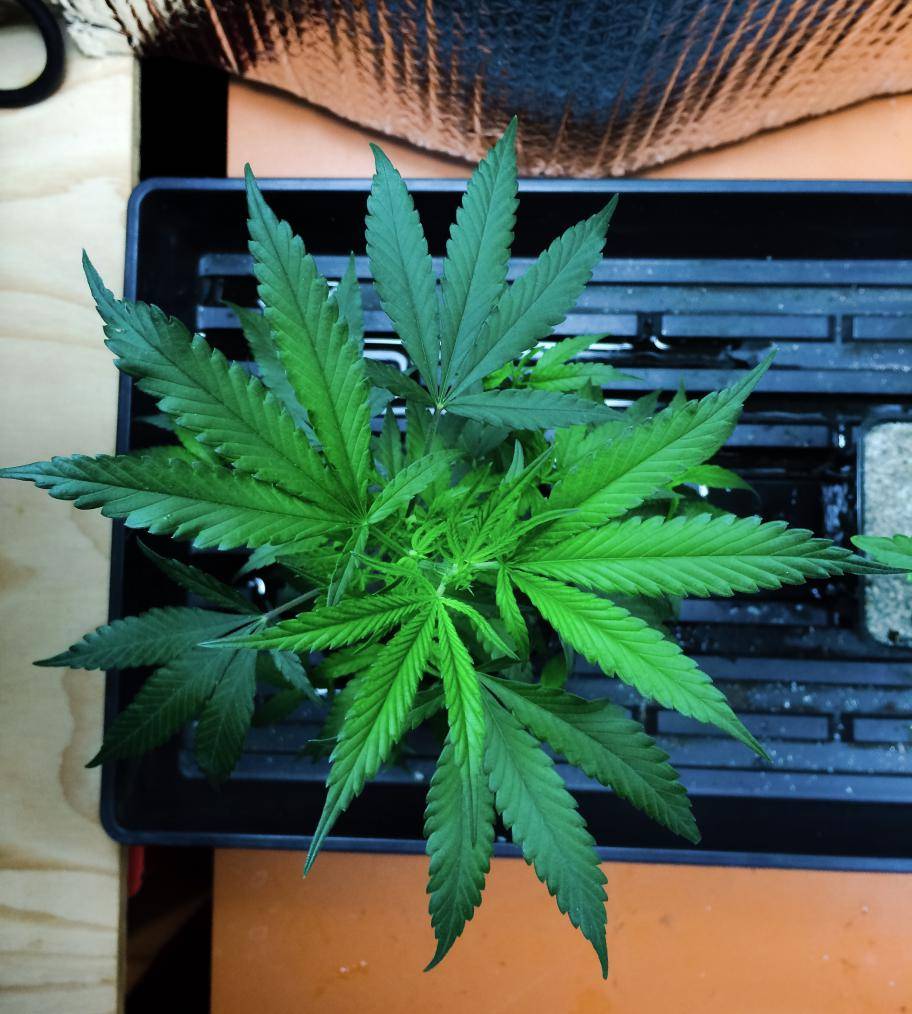
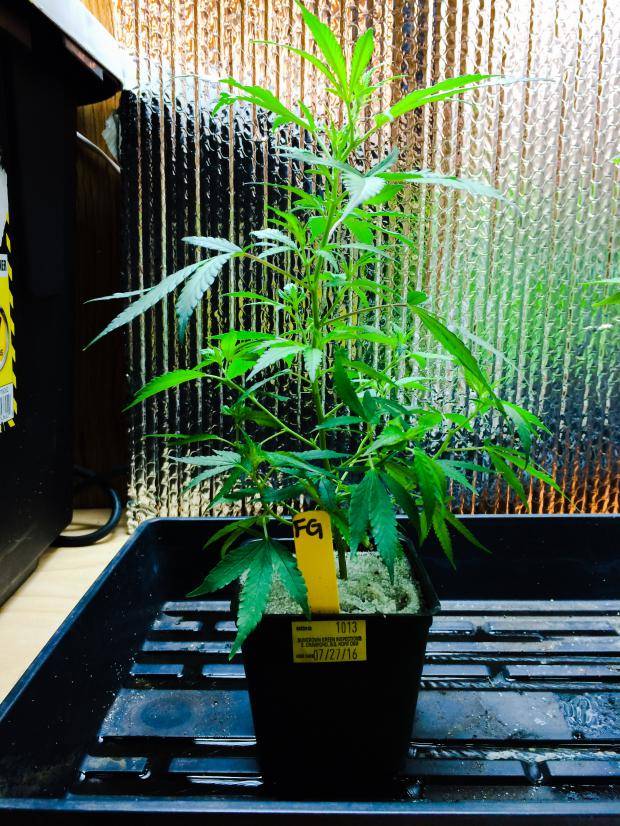
Lambs Sour Diesel
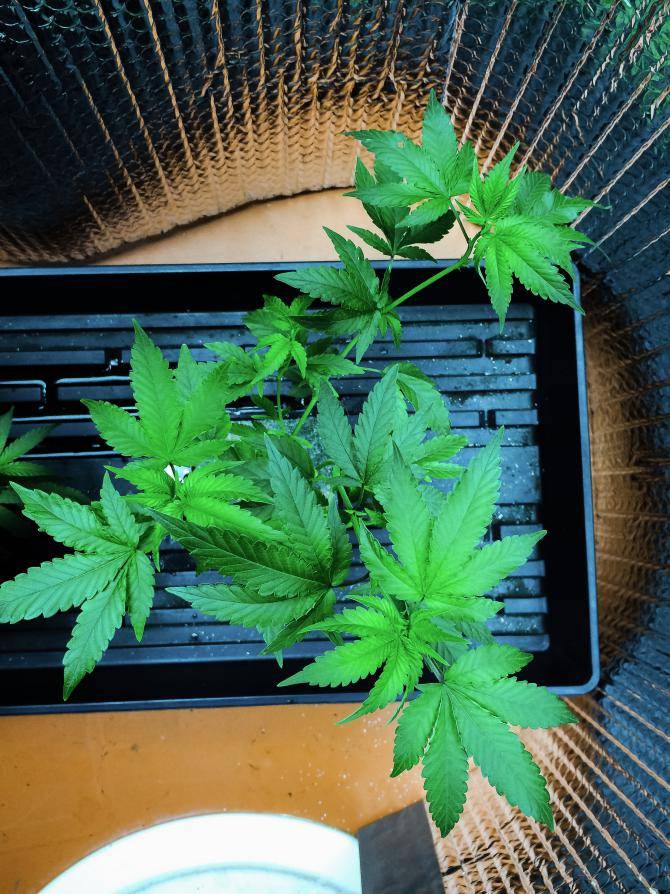
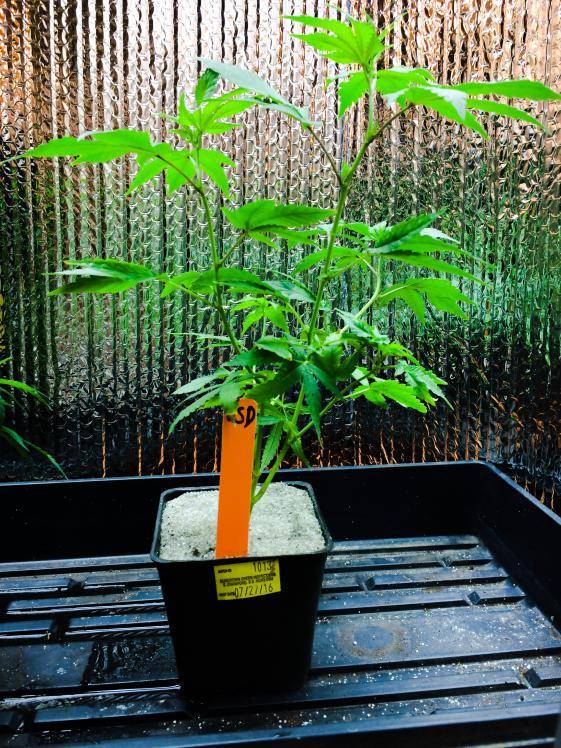
The adopted kids are staying in quarantine until they've been thoroughly inspect just before transplanting, I don't know why they even bother having a lab certify them as being pest free, they always have the door open to the clone room, they don't filter the air into the room, and they walk into the room in their street clothes. Oh, and they use used grocery store bags to house the clones when they sell them to you, so ghetto, they're not even packed in there with anything, just lose, and they tip over when you pick up the bag.
Well, what can you do, they're my local store, and I'm just happy we have one. Hopefully, over time they'll get better, what can you expect from a bunch of stoners
Well I think that does it for this installment, there was another incident with the ghost in my grow room last night, which is one of the reasons I was up until 6:23am, it kidnapped one of my dogs, but I'll save that story for another time.
Peace out homies.
The Final Chapter...
The Adoption
After losing all of those cuttings, and everything else that went down this week, I was really bummed. So I decided to take a trip down to the dispensary. Like all businesses these days, none of the employees have any knowledge about anything they're selling, no big surprise there. I was after some new clones, they had a decent selection, and there was quite a few strains I had never heard of. They used to have list of everything they carried, with genealogies, and even lab reports, but apparently they stopped updating it, so I sat down and started looking up strain information on my tablet, good thing I brought it.
The two strains I ended up getting I had heard of before, but had never tried them, and didn't know much about their backgrounds. The two new additions are Frank's Gift, and Lambs Sour Diesel. Here's some pics, I'll be transplanting them along with the Afghan seedlings tomorrow.
Frank's Gift
Lambs Sour Diesel
The adopted kids are staying in quarantine until they've been thoroughly inspect just before transplanting, I don't know why they even bother having a lab certify them as being pest free, they always have the door open to the clone room, they don't filter the air into the room, and they walk into the room in their street clothes. Oh, and they use used grocery store bags to house the clones when they sell them to you, so ghetto, they're not even packed in there with anything, just lose, and they tip over when you pick up the bag.
Well, what can you do, they're my local store, and I'm just happy we have one. Hopefully, over time they'll get better, what can you expect from a bunch of stoners
Well I think that does it for this installment, there was another incident with the ghost in my grow room last night, which is one of the reasons I was up until 6:23am, it kidnapped one of my dogs, but I'll save that story for another time.
Peace out homies.
I keep a small set of worm bins in my house made out of 27gal plastic totes, when spring came around, and the fungus gnats emerged, my worm bins got infected, so I sprinkled some neem meal on the top of the coco/peat in the bins, and that seemed to do the trick. About a week or two later when I was adding some food scraps to the bins, I noticed these really tiny, fast moving insects, light tan in color. I tried to search the web, and forums for what they might be, and I couldn't find anything like them.
All throughout my last flower cycle, I would add worms and worm castings from my worm bins. Instead of buying worms to start my bins, I collected them throughout the spring, as I would find them under pots, and pieces of cardboard in my outdoor gardens. Along with the worms, I collected woodlice, centipedes, and what ever else came along for the ride with the gathered worms. The small tan insects from my worm bins soon found their way into my grow rooms, and their population exploded, I began to worry.
I checked my plants often and never noticed any insect damage or stress from the infestation in the soil. They also never ventured up onto my plants as far as I could see. After I was done harvesting and had chopped up the stems and leaves from the crop to place on top of the soil, the fungus gnats came back in force. I'm currently in the middle of the worst infestation I've ever had, it's like a biblical plague.
I don't have the money yet to buy benificial insects. All I have on hand is a big container of mosquito bits, so I've been applying those, and some more neem meal. I have noticed though that I don't see as many of the tan little bugs after applying neem meal, I think it's messing with them. I've been searching forums and the net, for other controls, and other peoples experience with BTI. I've used it before on small outbreaks, with success, but never anything like my current infestation. I found another thread on another site, detailing an infestation like mine, and they were using mosquito bits to control them, and they also have tons of the tiny tan insects just like mine in their soil, and they had identified them as Macrocheles Robustulus, a benificial predator mite.
So now it all makes sense, the mites population explodes when the fungus gnats come back, I'm really stoked that I have those little buggers helping me fight, and I didn't even have to buy them. I can't wait until I have the nematodes as well.
It took some time but I finally got a clear pic of the mites, they are very tiny, and also very fast. I took this pic with my phone, and a cheap little 60x magnifying lenses that clips onto my phone. I adjusted the color and contrast of the picture to show more detail.
Here it is Macrocheles Robustulus
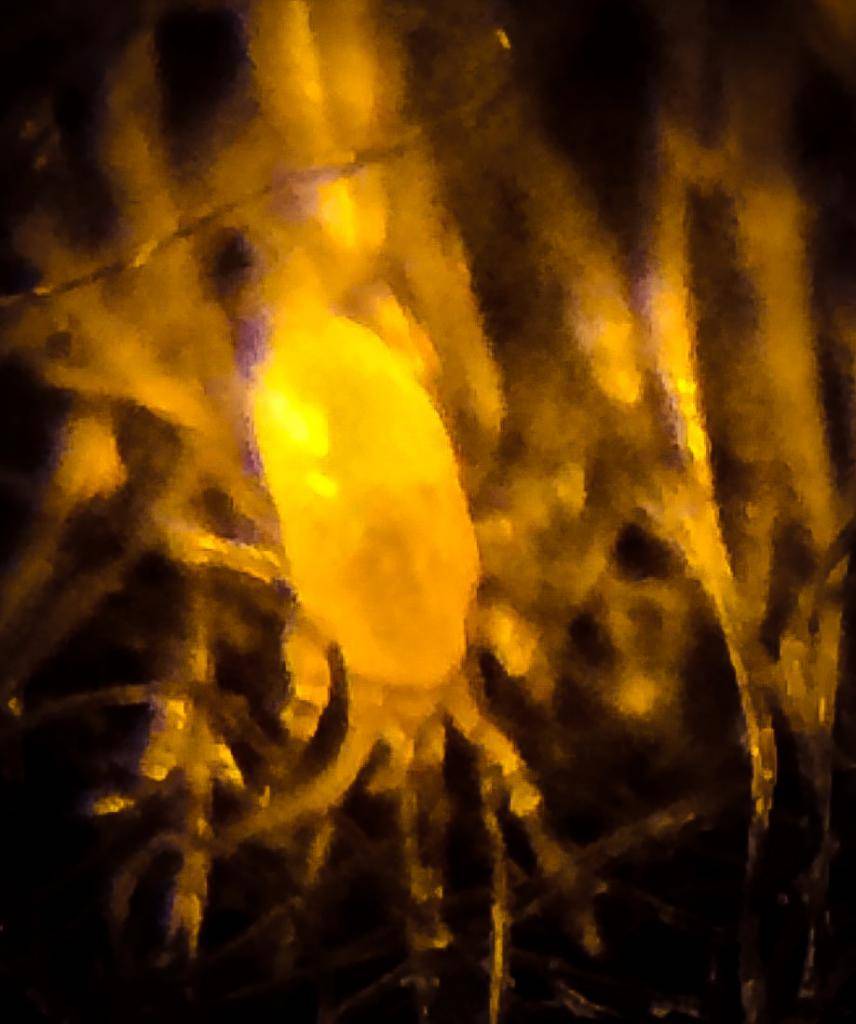
When I was cleaning the floor of my flower room this last time, I found something strange, and I couldn't figure out what it could be. In the corners of the room, and under some of the bed carts, I found this strange dust, but the pieces were all uniform. At first I thought maybe it was parts of dead fungus gnats, that somehow became semi translucent. Last night I believe I figured out what that dust was. When I was checking my soil for fungus gnat larvae. For the first time in a couple of weeks it was difficult to find larvae, as I was scanning I started noticing more and more mites crawling out of the mulch, then they began crawling out of my beds. When I checked on the flower room tonight I noticed there were thousands of mites, stuck and dead on the sides of my fabric beds. They were also all over the rolling carts the beds sit on, and all over the floor. The strange dust on my floor had been thousands and thousands of dead predator mites. I believe what's happening is that when there food source becomes low, they leave in a mass exodus. One interesting thing to note is that it appeared to be mostly younger mites, a fraction of the size of the adults.
The infestation of gnats in my flower room seems to be be coming to an end, but there is still a nasty infestation in my mom room. I've applied mosquito bits to both rooms several times, so unfortunately it doesn't seem to be working, and after searching the mothers beds I cannot find any predator mites, I had thought I'd seen some in there before, but it's pretty clear they're not. So tonight I scooped up some mulch from my flower room loaded with mites., and placed them in the pots in the mom room. That should do the trick, I hope...
All throughout my last flower cycle, I would add worms and worm castings from my worm bins. Instead of buying worms to start my bins, I collected them throughout the spring, as I would find them under pots, and pieces of cardboard in my outdoor gardens. Along with the worms, I collected woodlice, centipedes, and what ever else came along for the ride with the gathered worms. The small tan insects from my worm bins soon found their way into my grow rooms, and their population exploded, I began to worry.
I checked my plants often and never noticed any insect damage or stress from the infestation in the soil. They also never ventured up onto my plants as far as I could see. After I was done harvesting and had chopped up the stems and leaves from the crop to place on top of the soil, the fungus gnats came back in force. I'm currently in the middle of the worst infestation I've ever had, it's like a biblical plague.
I don't have the money yet to buy benificial insects. All I have on hand is a big container of mosquito bits, so I've been applying those, and some more neem meal. I have noticed though that I don't see as many of the tan little bugs after applying neem meal, I think it's messing with them. I've been searching forums and the net, for other controls, and other peoples experience with BTI. I've used it before on small outbreaks, with success, but never anything like my current infestation. I found another thread on another site, detailing an infestation like mine, and they were using mosquito bits to control them, and they also have tons of the tiny tan insects just like mine in their soil, and they had identified them as Macrocheles Robustulus, a benificial predator mite.
So now it all makes sense, the mites population explodes when the fungus gnats come back, I'm really stoked that I have those little buggers helping me fight, and I didn't even have to buy them. I can't wait until I have the nematodes as well.
It took some time but I finally got a clear pic of the mites, they are very tiny, and also very fast. I took this pic with my phone, and a cheap little 60x magnifying lenses that clips onto my phone. I adjusted the color and contrast of the picture to show more detail.
Here it is Macrocheles Robustulus
When I was cleaning the floor of my flower room this last time, I found something strange, and I couldn't figure out what it could be. In the corners of the room, and under some of the bed carts, I found this strange dust, but the pieces were all uniform. At first I thought maybe it was parts of dead fungus gnats, that somehow became semi translucent. Last night I believe I figured out what that dust was. When I was checking my soil for fungus gnat larvae. For the first time in a couple of weeks it was difficult to find larvae, as I was scanning I started noticing more and more mites crawling out of the mulch, then they began crawling out of my beds. When I checked on the flower room tonight I noticed there were thousands of mites, stuck and dead on the sides of my fabric beds. They were also all over the rolling carts the beds sit on, and all over the floor. The strange dust on my floor had been thousands and thousands of dead predator mites. I believe what's happening is that when there food source becomes low, they leave in a mass exodus. One interesting thing to note is that it appeared to be mostly younger mites, a fraction of the size of the adults.
The infestation of gnats in my flower room seems to be be coming to an end, but there is still a nasty infestation in my mom room. I've applied mosquito bits to both rooms several times, so unfortunately it doesn't seem to be working, and after searching the mothers beds I cannot find any predator mites, I had thought I'd seen some in there before, but it's pretty clear they're not. So tonight I scooped up some mulch from my flower room loaded with mites., and placed them in the pots in the mom room. That should do the trick, I hope...
Good idea!
Hypoaspis Miles will most likely stick around and keep a nice balance between friend and foe I've learned. They could be eating some type of larvae (fungus gnats it sounds like) so that's a good sign. Weird how they started dying in mass amounts though.
I bet your plan works, they'll populate quickly in your mom room and should get a hold on things once and for all. If not, consider some neem meal mixed with EWC at 1-2 tbsp per container - this has worked for me for over 2 years now
Hypoaspis Miles will most likely stick around and keep a nice balance between friend and foe I've learned. They could be eating some type of larvae (fungus gnats it sounds like) so that's a good sign. Weird how they started dying in mass amounts though.
I bet your plan works, they'll populate quickly in your mom room and should get a hold on things once and for all. If not, consider some neem meal mixed with EWC at 1-2 tbsp per container - this has worked for me for over 2 years now
Good idea!
Hypoaspis Miles will most likely stick around and keep a nice balance between friend and foe I've learned. They could be eating some type of larvae (fungus gnats it sounds like) so that's a good sign. Weird how they started dying in mass amounts though.
I bet your plan works, they'll populate quickly in your mom room and should get a hold on things once and for all. If not, consider some neem meal mixed with EWC at 1-2 tbsp per container - this has worked for me for over 2 years now
A couple things about the neem meal. I already have a large amount in my soil, and I've repeatedly applied it to the surface to combat the fungus gnats. I'm worried about overloading on it, which can cause problems with seed germination, and certainly overload my nitrogen levels.
When you say 1-2 tbsp are you referring to the amount off neem, or the neem EWC mixture? I have large raised beds in my flower room, I would need an idea of how much to add per square foot of surface area. My beds are pretty tall as well, and the fungus gnats crawl down the sides where the soil seperates from the fabric as the soil dries. So while I can apply neem to the top, I can't get the sides well.
Thinking about it it's not strange to my why they died in large amounts, they're pretty small, there were many dead juveniles stuck to the outside walls of my fabric beds, I think they got stuck in the fabric, I found no adults that died this way, once they make it down the beds, and onto the floor, it's basically a desert, devoid of water and food, since the beds sit on carts with wheels, it's not easy to get back into the beds, as they only contact the ground at the wheels. I imagine that it took the ones that made it to the floor a good deal of time to get there, as they would have to find the small wheels to crall down. Once on the floor they are stuck, not being able to find another food or water source. Some of the dust piles of thier dead bodies were over an inch thick, that's a lot of dead mites. Moving as fast as they do, they probably need to eat regularly.
Why does mixing EWC and neem meal combat fungus gnats? With both neem and EWC in my worm bins how did the fungus gnats take hold in there?
A couple things about the neem meal. I already have a large amount in my soil, and I've repeatedly applied it to the surface to combat the fungus gnats. I'm worried about overloading on it, which can cause problems with seed germination, and certainly overload my nitrogen levels.
When you say 1-2 tbsp are you referring to the amount off neem, or the neem EWC mixture? I have large raised beds in my flower room, I would need an idea of how much to add per square foot of surface area. My beds are pretty tall as well, and the fungus gnats crawl down the sides where the soil seperates from the fabric as the soil dries. So while I can apply neem to the top, I can't get the sides well.
Thinking about it it's not strange to my why they died in large amounts, they're pretty small, there were many dead juveniles stuck to the outside walls of my fabric beds, I think they got stuck in the fabric, I found no adults that died this way, once they make it down the beds, and onto the floor, it's basically a desert, devoid of water and food, since the beds sit on carts with wheels, it's not easy to get back into the beds, as they only contact the ground at the wheels. I imagine that it took the ones that made it to the floor a good deal of time to get there, as they would have to find the small wheels to crall down. Once on the floor they are stuck, not being able to find another food or water source. Some of the dust piles of thier dead bodies were over an inch thick, that's a lot of dead mites. Moving as fast as they do, they probably need to eat regularly.
Why does mixing EWC and neem meal combat fungus gnats? With both neem and EWC in my worm bins how did the fungus gnats take hold in there?
Just don't add more than 1 cup per cubic foot total and you'll be more than ok. I do it all the time and have my containers going for 2 years now... no ill effects from 1/4 cup of neem mixed with ewc/other goodies as a top dress. Promise!
Nature doesn't work like that anyways, the plant will uptake only as much as is needed when it needs to do so, so unless you go really crazy with the neem you won't have any problems for the most part. It is a staple in my routine, period.
I would add somwhere around 1 tbsp for every 2 square feet.
The EWC/neem meal combo is so effective because the neem meal is a systematic killer, and is a sure shot at eradicating pest species (in time). The ewc helps the neem become bioavailable and also has important enzymes from the worms' gut to combat pests such as gnats.
I'll give it another shot next time I have an infestation, as it is now the predator mites are doing their job. The next thing I'm going to try is growing my own nematodes. If that's unsuccessful I'm going to buy the smallest amount I can and try to get them to multiply before putting them in my soil.
I also need to research neem meal a bit more, I think my predator mites were affected by it.
At some point I'd really like to get away from using neem products unless I can grow some trees in my greenhouse.
I also need to research neem meal a bit more, I think my predator mites were affected by it.
At some point I'd really like to get away from using neem products unless I can grow some trees in my greenhouse.
I'll give it another shot next time I have an infestation, as it is now the predator mites are doing their job. The next thing I'm going to try is growing my own nematodes. If that's unsuccessful I'm going to buy the smallest amount I can and try to get them to multiply before putting them in my soil.
I also need to research neem meal a bit more, I think my predator mites were affected by it.
At some point I'd really like to get away from using neem products unless I can grow some trees in my greenhouse.
Please do! And I thought the same exact thing at one time... so I don't blame you there lol. Here's something I just dug up for you:
Why use neem for pest control?
Pests are often controlled with man made chemicals which have many
harmful effects.
• Artificial chemicals kill useful insects which eat crop pests.
• Artificial chemicals can be very bad for the health of people who use them and people who eat food with small amounts of chemicals in the skin, the leaves or on the surface.
• Artificial chemicals can stay in the environment and in the bodies of
animals causing problems for many years.
• Artificial products are very simple chemicals and insect pests can very quickly, over a few breeding cycles, become resistant to them and can no longer be controlled.
• Artificial chemicals are often expensive and unaffordable.
Neem, however, has properties which are very effective against many pests and diseases, and it is not harmful to the environment.
• Neem contains several active chemicals which work in different ways. As a result of this, pests are unlikely to become resistant to neem. The most well known natural chemical in neem is azadirachtin.
• Neem is easy to prepare and use, and is environmentally safe and not harmful to man and animals.
• Neem does not usually affect beneficial insects, for example those that eat crop pests. This is because neem extracts must be eaten to take effect. Insects that feed on plant tissue are likely to be affected but those that feed on nectar or other insects are unlikely to eat enough neem extract to be affected. Beneficial insects include bees, parasitic wasps, spiders and ladybirds.
Below I've attached the article, it's a pretty good one I think
Attachments
There are some stated relevant points concerning the use of neem products and the possibility of a negative impact on the organisms we wish to preserve.
Weird has stated the importance of correct use. Team Microbe has shown a document which restates the scientific observations supporting, that it does not effect predators (beneficial insects). These state that the active ingredients in neem must be ingested by the pest insect to negatively impact it.
Following this observation, the hypothesis (or theory) would be that predatory insects would be unaffected because they eat bugs not plants. Also there would be 2 ways for pests to consume the ingredients; either residually or by ingesting/sucking ingredients which had spread systemically throughout the plant.
This makes sense and does provide a logical basis for using neem products as an organic pest control in many circumstances. Using it correctly cannot be overstated.
I believe that Mike has pointed out using an oil is likely going to have the effect of smothering arthropods, pest or beneficial. I agree with this and think these solutions should be avoided if one is wanting to preserve beneficial insects. Also consider the similar potential effects of the oil on microorganisms if it gets into the soil.
We should also consider another couple of thoughts (if highly dependent on living soil natural growing). If a bug or larva is poisoned by neem products and is then ingested by a predatory arthropod, what is the effect upon the eater?
What do we mean when we say beneficial? Are all our beneficial creatures only predatory? What about pill bugs, nematodes, millipedes, springtails, worms, etc. which eat decaying organic matter and microbes which ingest organic matter? These are also beneficial so in my thought process the supportive statements for the use of neem products using the predatory definition are narrow in scope and therefore skewed.
Does that mean one should not use neem products for control of pests? No. There are many reports from growers who use it very successfully for this and have the added bonus of a source of nutrient. As Weird says one must look to the plants' responses for guidance in individual use.
Growers should be aware of the possibility of negative impacts but take care to use the products correctly and carefully. Or if the grower is fully tuned to the living soil paradigm they may wish to make closer observations to see what is going on (microscopy, etc).
Weird has stated the importance of correct use. Team Microbe has shown a document which restates the scientific observations supporting, that it does not effect predators (beneficial insects). These state that the active ingredients in neem must be ingested by the pest insect to negatively impact it.
Following this observation, the hypothesis (or theory) would be that predatory insects would be unaffected because they eat bugs not plants. Also there would be 2 ways for pests to consume the ingredients; either residually or by ingesting/sucking ingredients which had spread systemically throughout the plant.
This makes sense and does provide a logical basis for using neem products as an organic pest control in many circumstances. Using it correctly cannot be overstated.
I believe that Mike has pointed out using an oil is likely going to have the effect of smothering arthropods, pest or beneficial. I agree with this and think these solutions should be avoided if one is wanting to preserve beneficial insects. Also consider the similar potential effects of the oil on microorganisms if it gets into the soil.
We should also consider another couple of thoughts (if highly dependent on living soil natural growing). If a bug or larva is poisoned by neem products and is then ingested by a predatory arthropod, what is the effect upon the eater?
What do we mean when we say beneficial? Are all our beneficial creatures only predatory? What about pill bugs, nematodes, millipedes, springtails, worms, etc. which eat decaying organic matter and microbes which ingest organic matter? These are also beneficial so in my thought process the supportive statements for the use of neem products using the predatory definition are narrow in scope and therefore skewed.
Does that mean one should not use neem products for control of pests? No. There are many reports from growers who use it very successfully for this and have the added bonus of a source of nutrient. As Weird says one must look to the plants' responses for guidance in individual use.
Growers should be aware of the possibility of negative impacts but take care to use the products correctly and carefully. Or if the grower is fully tuned to the living soil paradigm they may wish to make closer observations to see what is going on (microscopy, etc).
Well put MM, and thank you TM, beyond all of these points, I don't think I'll be able to cost effectively produce the neem products, which means if I become skilled at using the products, and begin to lean on them, I become stuck, and with the rapidly increasing cost of fuel, and well, everything else, I wish to at some point become completely self sufficient, or as close to it as I can get. I'm working on a heating system for my greenhouses, using tubing, water, and compost. I'll make enclosures for the piles in front of my greenhouses. I'll use the soiled goat bedding from my barn, when piled up it gets very very hot, rather quickly, the tubing is coiled in the piles, and water is run through the tubing and into the greenhouses. Some will be run into the benches, to hear those, and the rest to radiators. I can also use wood chips for this process. There a few other things to add to the green houses, like water tanks and raised beds, to slow down the temperature shifts. Anyways, once I have a free heat source, I can start to grow tropical plants in the greenhouses. Then perhaps neem will make more sense in the long run.



